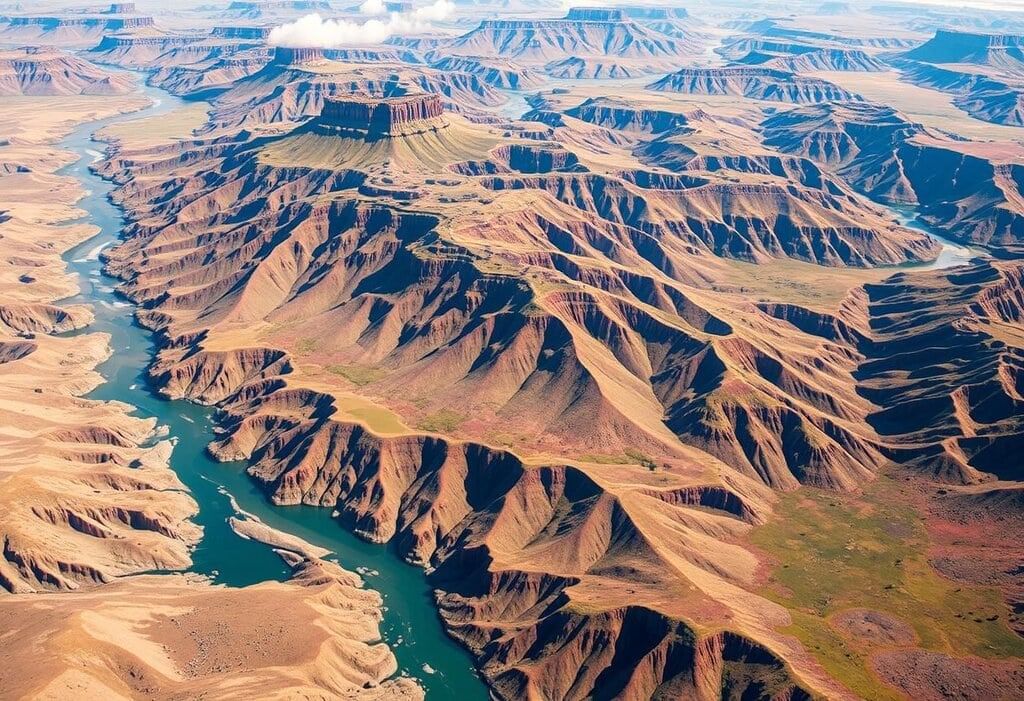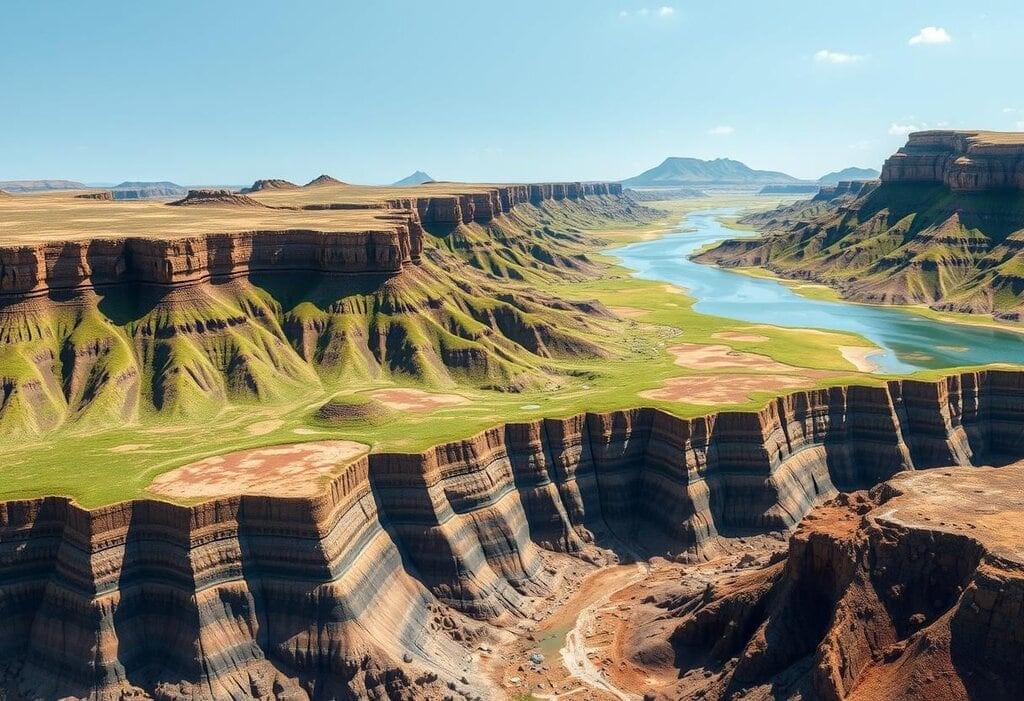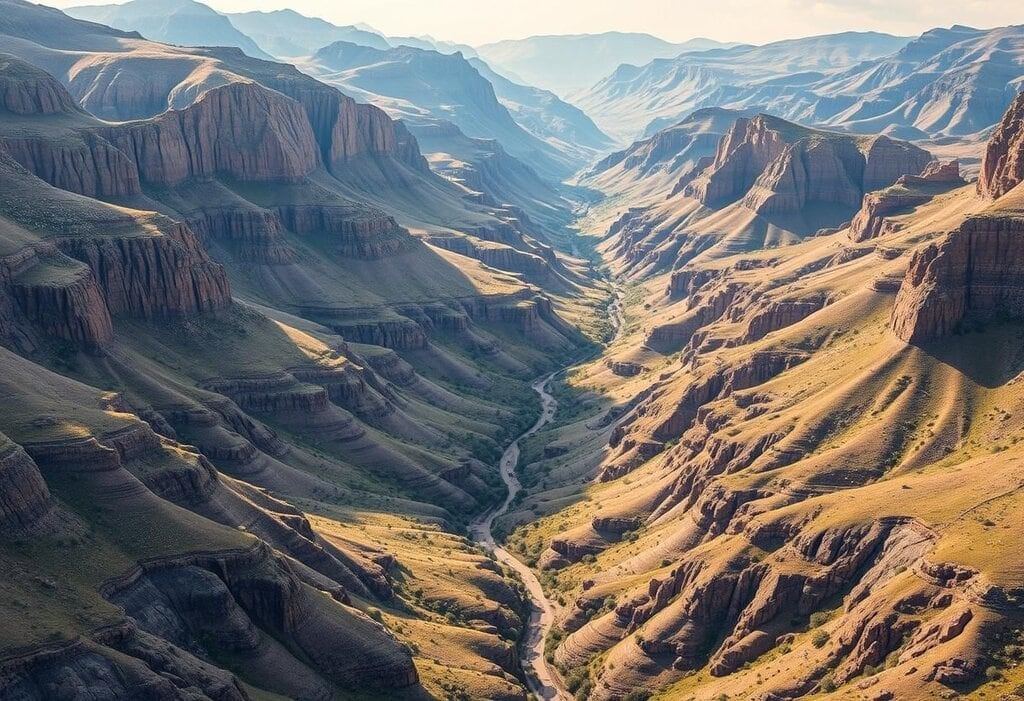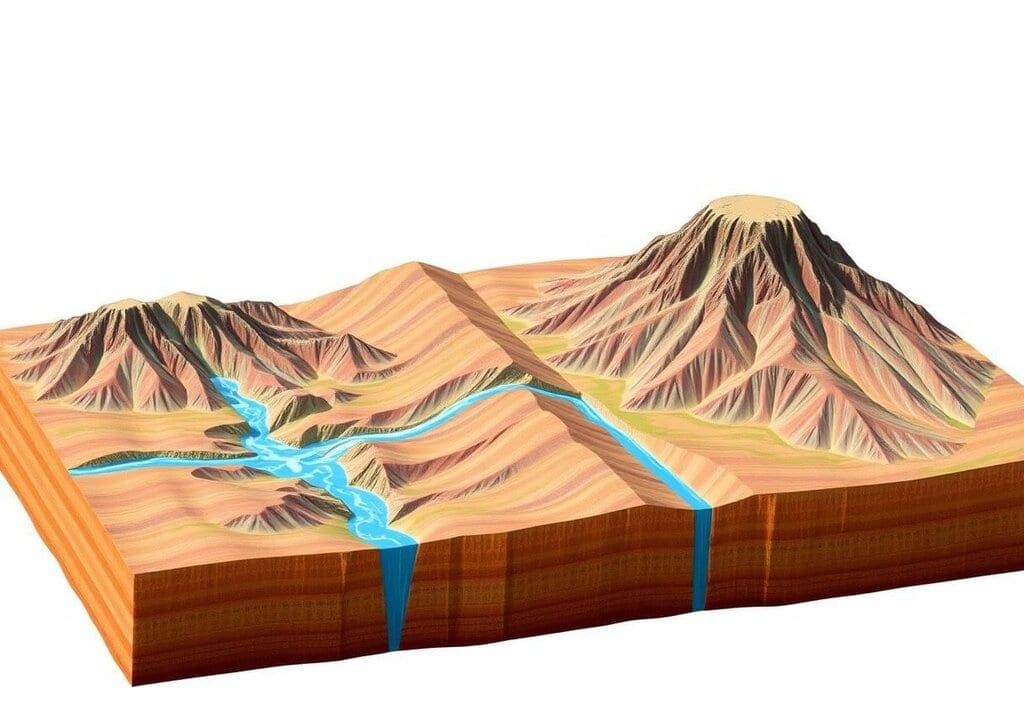Savindra Singh Summary: Theories of Landform Development | Geography Optional for UPSC PDF Download
Introduction
 Dynamic Landscapes
Dynamic Landscapes
The chapter delves into geomorphic theories, emphasizing the absence of a universal theory while discussing their significance, historical context, various types, and evaluations of key models. It underscores the complex nature of landform development, highlighting the necessity for diverse theoretical perspectives.
Absence of a Universally Accepted Theory
Overview
No single geomorphic theory can fully explain the evolution of landforms due to differing perspectives on:
- The cyclic development of landforms
- Dynamic equilibrium
- Specific processes and structures
- Climatic influences
- Tectonic activity
Key Points
 Geological Diversity
Geological Diversity
- Diverse Theories: Various theories investigate cyclic evolution (like Davis), dynamic equilibrium (non-cyclic), process-geomorphology, structural geomorphology, climatic geomorphology, tectonic geomorphology, and episodic erosion. However, none of these theories have gained widespread acceptance.
- Complexity of Landscapes: Differences in factors such as geology, tectonics, climate, vegetation, and human activity contribute to the complexity of landscapes. These factors are interrelated and lead to diverse landscapes that cannot be simplified into a single model.
- Oversimplification Critique: C.G. Higgins and S. Schumm argue that overly simplistic models fail to account for short-term changes and regional differences. Many theories are based on limited studies, which do not capture the full range of landscape variability.
- Need for Multiple Theories: Higgins emphasizes the necessity of multiple theories to explain landform development in different environments. No single model can adequately describe all situations of landform development.
- Indian Example: The Bhander Plateau in India, with its distinctive geological features and pronounced topography, illustrates how parallel retreat (as per the Penckian model) and slope decline (according to the Davisian model) can occur simultaneously. This example highlights the need for composite theories that integrate different models.
Importance and Objectives of Geomorphic Theories
 Geological Evolution
Geological Evolution
Geomorphic theories play a crucial role in describing, classifying, and explaining the processes involved in the creation of landforms. By doing so, they enhance our understanding of how these landforms are formed and how they evolve over time.
Main Objectives
- Descriptive: Geomorphic theories aim to provide a detailed and comprehensive overview of the various features associated with different landforms.
- Taxonomic: These theories seek to systematically organize landforms into categories, making it easier to study and understand their differences and similarities.
- Genetic/Evolutionary:. key goal is to clarify the processes through which landforms originate and how they develop over time. This includes understanding the relationships between the processes that create landforms and the characteristics of those landforms.
- Ideal Theory Properties: According to Higgins, effective theories should be written in clear and simple language, align with current geological concepts, and be useful for historical analysis as well as future predictions.
Historical Overview of Geomorphic Theories
 Geological Cycles
Geological Cycles
Geomorphic theories have evolved from early religious and catastrophic explanations to scientific models. This evolution was significantly influenced by figures like G.K. Gilbert, W.M. Davis, and others.
Key Developments
- Pre-Davisian Era. Early ideas of catastrophism and Hutton's uniformitarianism laid the groundwork. Gilbert introduced scientific principles such as the laws of uniform slope and equilibrium, although a formal theory was not yet established.
- Davisian Era (1899). W.M. Davis proposed the model of the geographical cycle, emphasizing cyclic evolution through three stages: youth, mature, and old. This model was applicable in various environments, including arid, glacial, and karst areas, demonstrating the progression and development of landforms over time.
- Post-Davisian Era. The reevaluation of Davis's model led to new alternatives, such as W. Penck's morphological analysis (1924) and L.C. King's pediplanation cycle (1948). Quantitative approaches by Horton and Strahler (1930s–1950s) also emerged. Other theories included dynamic equilibrium (Strahler, Hack) and episodic erosion (Schumm).
Bases and Types of Geomorphic Theories
 Erosion Dynamics
Erosion Dynamics
Geomorphic theories are built on philosophical and scientific concepts and are categorized by R.J. Chorley based on their fundamental assumptions.
Types of Theories
- Teleological: Early theories proposed that landforms were shaped by a divine force, evident in catastrophism, which believed in rapid, large-scale events.
- Immanent: This theory examined the natural connections between erosion, deposition, and geology, as seen in Hutton’s uniformitarianism and the works of Lesley, Smith, and Powell.
- Historical: Emphasized evolutionary patterns and retrodiction, such as Davis’ geographical cycle and denudation chronology, though criticized for speculative long timescales.
- Taxonomic: Classified landforms by region based on climate and shape factors, like morphogenetic regions identified by Budel and Peltier.
- Functional: Investigated cause-and-effect relationships between forms and processes using quantitative methods post-WWII, as seen in the works of Horton and Strahler.
- Realist: Expanded functional theory by exploring small-scale physical and chemical processes in geomaterials, demonstrated by Gilbert and Scheidegger.
- Conventionalist: Integrated realist and practical approaches, focusing on small-scale studies for real-world applications, such as gully erosion research in India.
1. G.K. Gilbert’s Principles
 Rhythmic Balance
Rhythmic Balance
- Overview. Gilbert, known more as a researcher than a theorist, proposed concepts like dynamic equilibrium and the laws of uniform slope. His focus was on measurement and steady-state systems.
- Key Concepts. According to Gilbert, landscapes maintain balance through rhythmic and oscillating changes brought about by opposing forces, specifically driving and resisting forces. He believed that time operates in cycles and that processes can be measured using principles from thermodynamics.
- Evaluation. Gilbert’s groundbreaking ideas, such as the concept of steady state, have significantly influenced modern geomorphology and paved the way for future theories in the field.
2. W.M. Davis's Geographical Cycle
 Geological Serenity
Geological Serenity
- Overview. Davis's model describes the gradual transformation of landforms over time, progressing through distinct phases of youth, maturity, and old age, ultimately culminating in a flat landscape known as a peneplain. This process is influenced by the interplay of geological structure, natural processes, and the dimension of time.
- Key Assumptions. The model is founded on the principles of rapid geological uplift followed by erosion, a specific sequence of landform transformations, and the concept of rivers achieving a state of equilibrium.
- Stages.
- Youthful. This stage is marked by rapid valley deepening, the formation of V-shaped valleys, and an increase in topographical relief.
- Mature. In this phase, lateral erosion becomes prominent, resulting in wider valleys and a reduction in topographical relief.
- Old. The old stage is characterized by minimal vertical erosion and the extensive development of a peneplain, a nearly flat landscape.
- Evaluation.
- Positives. The model is praised for its simplicity, broad applicability, grounding in practical observations, and integration of contemporary concepts.
- Negatives. Critiques of the model include its unrealistic assumptions regarding geological uplift, an excessive emphasis on the factor of time, neglect of tectonic instability, and reliance on observational data rather than detailed measurements of geological processes.
W. Penck's Morphological System
 Geological Balance
Geological Balance
Introduction: Penck put forward his own system of categorizing landforms, which he believed were the result of a balance between uplift and erosion, rather than a linear progression through time.
Core Ideas: According to Penck, the landscape is shaped by the continuous interaction between the movement of the Earth's crust and the processes of erosion. He emphasized that the steepness and shape of hillsides are determined by how quickly material is cut away and how fast debris is removed.
Critique: Penck's ideas were initially not well-received, partly because his work was incomplete and his concepts were difficult to understand. While his theory introduced the idea of dynamic equilibrium in landscape formation, it struggled to gain traction due to its complexity and the dominance of earlier geological theories.
4. L.C. King’s Pediplanation Cycle
 Textured Terrain
Textured Terrain
Overview: King’s model, which is based on African landscapes, describes the process of pediplanation as the gradual retreat of scarps and the merging of pediments. This concept differs from Davis’ idea of downwasting, which involves a different mechanism of landscape evolution.
Key Differences: In King’s model, pediplains expand headward, meaning they grow in the direction of the slope’s origin. This is in contrast to stationary peneplains, which do not show such expansion. Additionally, pediplains share similarities with Penck’s concept of piedmont treppen, known for their distinct geomorphological characteristics.
Evaluation: King’s model has not received widespread attention, particularly with the increasing focus on quantitative geomorphology. Its applicability and relevance have been subjects of debate, making it a controversial perspective in the field of geomorphology.
5. J.T. Hack’s Dynamic Equilibrium
 Geological Harmony
Geological Harmony
- Overview: Hack’s model proposes that landscapes exist in a state of steady balance within open systems. This balance is a result of ongoing adjustments in rock types and continuous geological processes.
- Key Premises: The model is based on several key ideas:
- There is a balance between the wear and tear on the land and the strength of the rocks.
- Erosion occurs uniformly and steadily downward.
- The types of rocks present significantly influence the shapes and features of the landscape.
- Evaluation: While Hack’s model provides a different viewpoint compared to cyclic models, it faces challenges in explaining ancient landforms. Additionally, it relies on the notion that changes occur at a pace that may not be realistic.
M. Morisawa’s Tectono-Geomorphic Model
 Tectonic Evolution
Tectonic Evolution
Introduction: Morisawa’s model links landform development to the processes of plate tectonics. It emphasizes the interplay between tectonic forces and denudational processes, along with the resistance offered by different geomaterials.
Core Ideas: Landforms are the result of varying rates of internal (endogenetic) and external (exogenetic) processes. The model also highlights the role of isostatic feedback in maintaining a balance towards geological equilibrium.
Adaptability and Relevance: Morisawa’s model is flexible and supported by empirical evidence. It integrates concepts from both evolutionary and equilibrium perspectives, making it applicable to a wide range of tectonic settings.
S.A. Schumm's Episodic Erosion Model
 Erosion Dynamics
Erosion Dynamics
Overview: Schumm builds upon Davis's cyclic model by introducing the concept of episodic erosion. This approach considers the impact of geomorphic thresholds and the intricate interactions within river systems.
Key Concepts: Erosion occurs in distinct episodes rather than continuously. These episodes are characterized by alternating phases of instability, where erosion takes place, and stability, where deposition occurs. This process ultimately leads to the formation of stepped valley floors.
Evaluation: Schumm's model effectively combines elements of cyclic and equilibrium theories. It offers valuable insights into the formation of subtle landscape features. However, the complexity of subcycles within this model remains a subject of debate among researchers.
Indian Context: Bhander and Rewa Plateaus
 Geological Wonders
Geological Wonders
- Overview. The Bhander Plateau exemplifies the integration of various geomorphic theories, including parallel retreat (as proposed by Penck and King) and slope decline (Davis). The Rewa Plateau is characterized by scarps and waterfalls, indicative of tectonic activity (Morisawa).
- Key Observations. The occurrence of waterfalls and scarps in the Rewa Plateau highlights the influence of structural and tectonic factors. Meanwhile, Sharda Pole hill in the Bhander Plateau illustrates Davisian downwasting, providing support for multiple geomorphic theories.
- Conclusion. Understanding complex landscapes requires an integrated approach that considers lithology, tectonics, and various geomorphic processes.
The absence of a singular geomorphic theory underscores the intricate nature of landform development, which is driven by a variety of factors that differ across environments. While historical, cyclic, equilibrium, and tectonic models offer valuable perspectives, they cannot individually account for all types of landscapes. In India, composite theories offer a versatile framework by blending different viewpoints, emphasizing meticulous field observations and the interplay between geomorphic processes and landform shapes.
|
303 videos|635 docs|252 tests
|
FAQs on Savindra Singh Summary: Theories of Landform Development - Geography Optional for UPSC
| 1. What are the main objectives of studying geomorphic theories in geography? |  |
| 2. Why is there an absence of a universally accepted theory in geomorphology? |  |
| 3. What are the main types of geomorphic theories? |  |
| 4. How do geomorphic cycles contribute to our understanding of landscape development? |  |
| 5. Can you give a historical overview of significant geomorphic theories? |  |





















